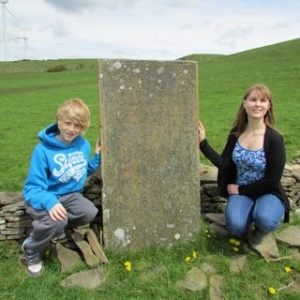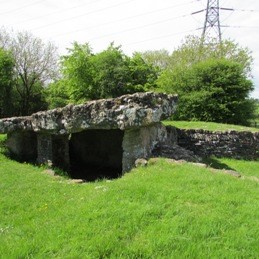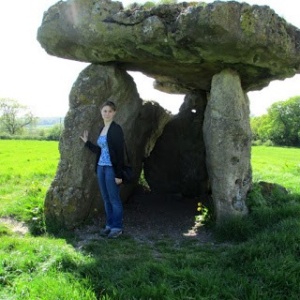Saturday, May 18, 2013
Today, Dad, Uncle Martin, and my two cousins, Sam (13) and Emily (10) set out to visit St. Peter’s Church (known locally as “The old church”) on the top of Brynna Mountain. Uncle Martin had “sussed out” a way to the church before we arrived, and was assured that a 2-mile hike beginning from the Griffon pub in Coed Ely would take us to our destination.
But just before we drove to Coed Ely, we met up with one of my Dad’s old acquaintances, Mr. Morgan, who told us a better route to the old church: up past Perry’s to a little bungalow a local woman had built, through a gate and along the track beyond. Nevertheless, with the promised 2-mile hike along a laneway sounding in our ears, we ignored Mr. Morgan’s advice (despite the fact that he’s lived in Brynna all his life) and drove to Coed Ely, where we promptly stumbled uphill into a bog.
Retracing our steps to the car, we drove over the commons—a steep track with extremely sharp corners—to the Brynna side, then went up Gelli fedi (pronounced “gechli veddy”) road, past Perry’s, and along a bumpy road to the bungalow. There, just visible about a mile away, were the ruins of the old church.
The swinging gate that led to the field we would have to cross had a massive mud puddle on the other side, so while Dad, Uncle Martin, Emily and I inched around the fence posts, Sam held onto the gate and took a running start, then swung on the gate to pull it closed behind us (there were horses in the field, so we couldn’t leave it open). At the far end of the horse field, we reached a small stream with a wobbly stepping stone in it. Crossing this and a couple of barbed-wire fences brought us to a rugged scramble up toward the windmills at the top of Brynna Mountain. Once there, it was a short walk along a fence, a duck under a single strand of barbed wire, and we were at the ruins.
The old church has stood in ruins above Brynna for many years. It was built sometime in the thirteenth century as a parish church and as a way station for people journeying on pilgrimage (according to Mark Williams, a history teacher from Brynna village). Legend also has it (as it does in a number of locations in the UK!) that this is the final resting place of King Arthur.
If not King Arthur, it is the final resting place of a number of people, most of them from the Robert family.
We took a break on the church wall and ate lunch before making our way—much more swiftly—back down the mountain to our car.
A quick stop to pick up Aunty Dorothy and we were off again, this time to Tinkinswood Burial Chamber and St. Lythan’s Burial Chamber, located just off the A48.
Tinkinswood is a Cotswold Severn style tomb, called such because many like it have been found along the Severn River. It would have been built during the Stone Age by Neolithic man, approximately 6000 years ago. Its massive capstone weighs as much as 5 double-decker buses, and would have taken 200 men pulling on ropes made of honeysuckle to tug into place. The remains of 50 people—men, women, and children—were found intermingled with the bones of livestock in the tomb’s cyst. It has been suggested that the bodies may have been removed from the tomb at certain times or for certain ceremonies.
St. Lythan’s is located only 2 miles from Tinkinswood and is also a Cotswold Severn style tomb. Like Tinkinswood, it would have been built in the Stone Age by Neolithic man—about 6000 years ago. St. Lythan’s is much smaller than Tinkinswood, with a capstone weighing only 35 tons. Rumour has it that every Midsummer’s Eve this capstone flies off the mound and bathes in a nearby stream.
Tomorrow, we say goodbye to our family in South Wales and head north to Gwynedd—the part of Wales in which the majority of my historical fiction series is set. Check back soon!



